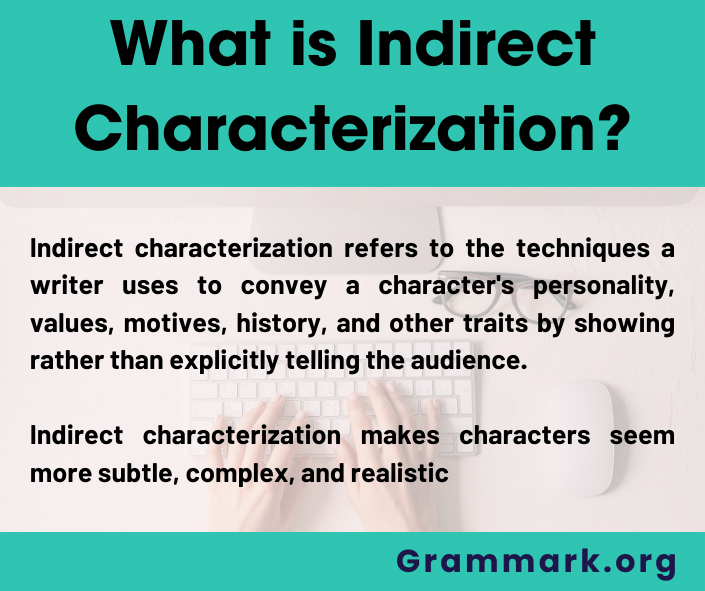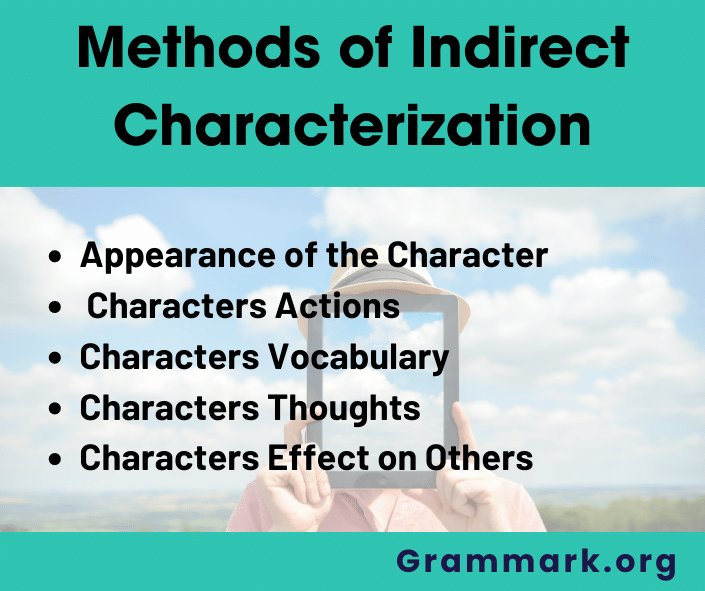Indirect characterization in literature is a way writers show what a character is like without saying it directly.
Instead of telling you a character is kind or brave, the writer shows it through actions, speech, thoughts, looks, or how others react to them. This method helps readers connect with characters and understand them better.
In this article, I’ll explain 5 simple ways to use indirect characterization in your writing. I’ll also share clear examples from shows and movies so you can see how it works and try it in your own stories.
What Is Indirect Characterization?
Indirect characterization refers to the techniques a writer uses to convey a character’s personality, values, motives, history, and other traits by showing rather than explicitly telling the audience.
The writer reveals details about the characters through their speech, thoughts, appearance, actions, and interactions.

Readers must make inferences about the character based on these details. Indirect characterization helps make a character more complex, nuanced, and lifelike.
Readers feel like they are organically discovering who the character is through small but significant hints.
Examples of Indirect Characterization
Here are some examples of indirect characterization:
- A character who always wears suits and polished shoes gives the impression of being formal, serious, and fastidious about appearance.
- A character who speaks with a lot of complex vocabulary and academic references may seem highly educated and intelligent.
- A character who goes out of their way to help strangers and donate to charity seems generous, kind-hearted, and community-oriented.
- A character who expresses cynical, pessimistic thoughts reveals a darker outlook on life.
- A character who makes everyone around them laugh comes across as witty, humorous, and charismatic.
Here are some famous examples of indirect characterization from movies and TV shows:
- The Terminator in “The Terminator franchise”: His tough, stoic demeanor and relentless determination indirectly convey his ruthless, machine-like nature.
- Darth Vader in “Star Wars”: His all-black menacing outfit and ominous breathing characterize him as a formidable villain.
- Forrest Gump in “Forrest Gump”: His childlike innocence and guileless view of the world indirectly signal his developmental disabilities and pure heart.
- Hannibal Lecter in “The Silence of the Lambs”: His polite speech, paired with a predatory stare, hints at the darkness beneath his refined surface.
- Cersei Lannister in “Game of Thrones”: Her penchant for wine and turbulent relationships indirectly hints at her inner instability and desperation for control.
- Chandler Bing in “Friends”: His constant sarcasm and witty comebacks indirectly reveal his intelligence and insecurity.
- Wolverine in “X-Men”: His gruffness and volatility beneath a caring heart come across through his angry outbursts and desire for solitude.
The writer reveals the personalities of these characters not through direct labels but through subtle clues that prompt readers to make connections.
5 Methods of Indirect Characterization
There are five main methods writers employ for indirect characterization:

1. Appearance
A character’s appearance offers clues about their personality, background, values, and habits. Their clothing, hairstyle, physical attributes, accessories, and style reflect aspects of their identity and how they want to present themselves to the world.
For example, a ragged, disheveled appearance may indicate homelessness, poverty, or depression. Expensive designer outfits can signify wealth and materialism. Tattoos and piercings can represent rebelliousness or unconventionality. Meticulous, formal clothing can convey conservatism. A character’s appearance is an important piece of how writers depict them indirectly.
2. Actions
The choices and actions a character makes regularly reveal their motivations, flaws, integrity, and priorities. Heroes characterize themselves through courageous deeds, while villains reveal their evil nature through malicious acts.
Selfless characters demonstrate compassion through their behavior. Characters unwilling to act showcase cowardice or apathy. Actions—and inaction—can subtly develop a character’s essence. Whether major plot points or small habits, a character’s actions indirectly exhibit who they are inside.
3. Words
Dialogue, speech patterns, and the ways characters communicate nonverbally supply personality clues. Shy, insecure characters mumble and avoid eye contact. Arrogant characters might boast and speak in a superior tone.
Intelligent characters use sophisticated vocabulary and make insightful remarks. Open-hearted characters speak warmly to others. Racist characters expose their prejudice through offensive language. Word choice, topics of conversation, and the manner of speaking colorfully reflect a character’s inner life.
4. Thoughts
A character’s private thoughts offer rich glimpses into their state of mind, attitudes, backstory, hidden motivations, secret fears, and inner turmoil, if revealed through first-person narration or a third-person omniscient perspective.
Characters unwilling to confide their candid thoughts in dialogue may still reveal themselves honestly through their inner monologues. A character’s unfiltered thoughts and emotions, invisible to other characters, open indirect windows into their psyches.
5. Effect on Others
How other characters respond to and interact with a particular character can indirectly convey if they are likable, intimidating, boring, frightening, or admirable. The company a character keeps—or repels—as well as others’ treatment and opinions of them, highlight unstated aspects of their nature and reputation.
For example, a character that children and animals instinctively shy away from may have a hidden dark side. A character that others gravitate toward for advice likely exhibits wisdom and compassion. Subtle interactions can speak volumes.
These five techniques often work together to create an indirect impression of a character. Through astute details, observations, and inferences, readers gain insights into who the characters are on the inside.
When Should You Use Indirect Characterization?
You should use indirect characterization when you want readers to slowly learn about a character by watching what they do, say, think, or how others react to them.
It works best in longer stories, when building mystery, or when showing how a character changes over time. This method helps make characters feel real and interesting, instead of just giving a list of traits.
To mention in short, it keeps readers more involved in the story.
Direct Vs. Indirect Characterization
Direct characterization states a character’s attributes. The writer directly informs the reader of key traits through exposition, descriptive labels, explanations of the character’s history, or overt judgments of their personality. Direct statements leave little doubt about a character’s qualities. For example:
- Jane was a brilliant, resourceful woman with an unflappable spirit.
- After years in foster care, Tom grew up to be a self-reliant but distant adult.
- Sarah possessed unmatched courage in the face of any danger or injustice.
While direct characterization can efficiently convey the gist of a character, it can also sound heavy-handed. It does not allow the audience to interpret the nuances of a character’s personality for themselves.
Did You Know: Direct Characterization has played a crucial role in shaping iconic characters in literature like Sherlock Holmes and Harry Potter. If you want to know more about Direct Characterization, check our article here.
Indirect characterization reveals the layers of a character’s identity more gradually through implication, inference, and observation. It shows rather than tells. Indirect characterization makes characters feel dynamic, authentic, and fully realized. Readers enjoy discovering the truth about characters using context, actions, and behaviors as clues.
How to Use Indirect Characterization in Writing?
Here are some tips for employing indirect characterization effectively:
- Reveal characters bit by bit over time, not all at once. Let readers slowly unravel who the characters are.
- Use literary techniques like similes, metaphors, and symbols to convey indirect information about characters’ unseen qualities, motives, and feelings.
- Focus on specific, vivid details, such as appearance, gestures, and habits, that hint at deeper aspects of personality. Specificity makes characters seem real.
- Show characters interacting with others to reveal strengths, weaknesses, and aspects of their reputation through the eyes of other characters.
- Dramatize revealing moments when characters’ words and actions are exceptionally characteristic of their values. These moments can encapsulate a core part of their personality.
- Keep indirect clues consistent rather than contradictory to build up a coherent impression of what makes the character tick.
- Leave some ambiguity at times to intrigue readers and allow them to reach their own interpretations about the subtler dimensions of characters.
Indirect characterization makes readers actively participate in understanding the characters. By planting meaningful clues about characters throughout a story, writers create intrigue, mystery, and moments of realization that hook readers.
Why Is Indirect Characterization Important?
There are several key reasons indirect characterization is powerful:

- It makes characters compellingly life-like and three-dimensional. Readers get a holistic sense of who the characters truly are.
- It allows more room for reader interpretation and analysis. Readers enjoy having the autonomy to deduce information on their own.
- It mimics how people come to understand others in real life through accumulated observations over time, not instant summaries.
- It enables more flexibility to slowly reveal unexpected aspects of characters that overturn the initial impressions created. Characters can grow and change over time in lifelike ways.
- It encourages writers to show rather than tell, which generally makes for more dynamic, engaging storytelling compared to direct exposition.
- It captivates readers in a plot-driven story by adding a satisfying element of character revelation and development throughout. The story becomes about more than just events.
For all these reasons, indirect characterization makes for richer, more lifelike characters and a more immersive reading or viewing experience overall. Mastering the craft of indirect characterization is key for writers across all genres.
Related Reads:
Conclusion: Indirect Characterization Connects With Readers Quickly
Indirect characterization is the best way to bring your characters to life. It allows readers to feel more connected and involved by discovering personalities through slight hints and actions.
Instead of telling everything, you’re inviting the reader to observe and understand. The more you practice this method, the more natural it will become in your storytelling.
Focus on small details, stay consistent, and trust your reader’s ability to understand the meaning of lines.
Recommended Read: You can also learn about direct characterization with our detailed guide!
FAQs
Direct characterization explicitly states a character’s attributes or personality traits. Indirect characterization reveals a character’s nature through their appearance, words, thoughts, actions, and impact on other characters.
The main types are appearance, actions, words, thoughts, and effects on others. Writers reveal characters through carefully placed details related to these aspects.
Indirect characterization makes characters seem more subtle, complex, and realistic. It allows readers to make their own inferences and interpretations about characters through implications. This engages readers more actively.
Examples include a character wearing trendy designer clothing, which suggests wealth, a character donating money to a charity, which shows generosity, or a character using a lot of technical jargon, which indicates intelligence. Their personality is shown, not told.
Writers should reveal details gradually, use literary devices, focus on specific actions and traits, show interactions with others, and keep revelations consistent yet intriguing. This builds indirect impressions subtly over time.


